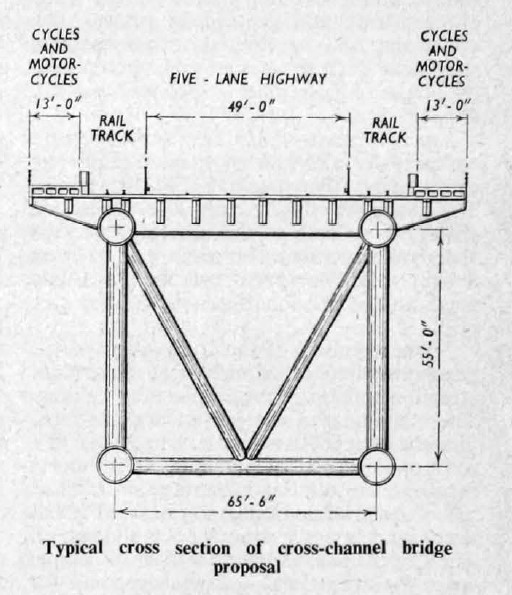
Since its founding in 1856 The Engineer has reported on the recurring ambitions of engineers determined to build a physical link between the UK and France.
Such efforts finally came to fruition in May 1994 when the Channel Tunnel opened after five years of construction, but as recently as 2018 the idea of a cross channel bridge was raised when Boris Johnson, in his capacity as foreign secretary, suggested a second crossing above the sea.
READ THE FULL ARTICLE FROM APRIL 1960
Serious suggestions for a cross channel bridge can be found in the March 1893 edition of The Engineer but fast forward 67 years and the same idea was being proposed in parallel to plans for a channel tunnel.
At the helm of such an undertaking was none other than Dorman Long (Bridge & Engineering) Ltd, the company that established its own iron and steel making facilities in Cleveland before diversifying into the bridge builder that would construct the Sydney Harbour Bridge, Denmark’s Storstrøm Bridge, the Bangkok Memorial Bridge and many more across the globe.
March 1876: Building a channel tunnel
January 1893: Another concept for a cross channel bridge
In April 1960, The Engineer had received a statement from Dorman Long that began: “A project and priced estimate for a channel bridge, prepared under the direction of the Compagnie Francaise d’Entreprises, has been submitted to the channel tunnel study group on behalf of that company, in association with Dorman Long (Bridge and Engineering), Ltd., and the Merritt-Chapman and Scott Corporation of America. The bridge solution to the problem of a channel crossing offers many advantages.”
Among them was the opinion that ‘an underground journey of 25 miles is not a subject for pleasant anticipation’. Similarly, a road and rail bridge would provide added safety in the event of a fire because ventilation failure ‘inherent in all long tunnels’ would ‘become of major significance in a tunnel 25 miles long.’
The statement added that road, rail and cycle traffic would be accommodated on a bridge structure without any interruption or check to the flow of traffic. Steam, diesel or electric propulsion could be used for trains and ‘the largest vehicles which can be accommodated on the roads of either country may pass freely on the bridge’ that would span 21 miles from the South Foreland near Dover to a point just south-west of Sangatte near Calais.
“Considerable investigations of the foundation conditions on the sea-bed have already been carried out,” continued the statement. “If subsequent investigations of the route proposed show any diversion to be advisable, this can readily be accommodated.”
Could any engineer fail to be impressed by the imaginative design of the proposed cross-Channel bridge?
The Engineer, 1960
The proposed bridge would provide a 49ft wide central five-lane highway; two rail-road tracks, one on each side of the highway directly over the bridge girders; and a 13ft wide overhanging ‘sidewalk’ on each side for cycle and motor-cycle traffic.
“The design is in accordance with British and French national loading standards and specifications,” read the statement. “On economic grounds for the conditions prevailing, a span of 740ft between pier centres has been adopted throughout the crossing, with the exception of two pairs of wider navigation openings situated on the sea routes on either side of the Varne Bank. A minimum headroom of 170ft at high water is available under the ordinary spans and 230ft in the navigation openings.”
The design of the bridge deck would have been based upon the orthotropic slab principle with the forms of the deck members proportioned ‘to induce deflection of the wind currents so as to protect vehicles using the bridge’, and a proportion of the project – such as assembly of the superstructure - would be executed at yards on both sides of the channel.
“Could any engineer fail to be impressed by the imaginative design of the proposed cross-Channel bridge?” asked an editorial in the same April edition of The Engineer. “Like all outstanding engineering proposals, it shows that imagination and a slide rule are complementary, yet both essential, to the engineer.”
“As engineers we feel excited by the thought that either scheme might be carried to completion,” the editorial continued. “But, alas, the slide rule will decide the issue here we think, and decide it in a negative way. In very round figures the capital cost of the tunnel, which would cost much more to operate than the bridge, is put at £100 million, and of the bridge at £200 million.
“Either project might be expected just about to pay its way, so it is thought. But the benefits seem scarcely adequate to justify such a large deployment of resources, particularly at a time when promising alternatives, such as the “Hovercraft” are being developed, and the need for civil engineering works of other kinds is so acute.”










PMI falls as manufacturers feel the squeeze
17 months or two and a half years - which is it?